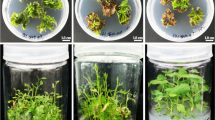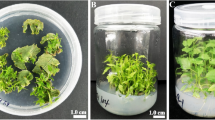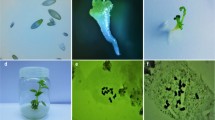Abstract
Populus is an important economical woody species due to its fast growth. In vitro induction of hexaploidy and investigation of morphological and anatomical characteristics in ((Populus alba × P. glandulosa) × P. tomentosa) were conducted in this study. Chromosome doubling was induced in vitro in a triploid clone ((Populus alba × P. glandulosa) × P. tomentosa) with oryzalin as a tubulin inhibitor. Nodal sections of 5 and 10 mm were exposed to 2.5 and 5.0 mg l−1 oryzalin for 24, 48 and 72 h. No significant differences in survival rates were observed between the different oryzalin dose, exposure time or nodal length; however, all rates were significantly lower than those in the no-oryzalin controls. The highest frequency of hexaploidy was 100% for the treatment of 5-mm nodes with 5 mg l−1 oryzalin for 72 h and the treatment of 10-mm nodes with 5 mg l−1 oryzalin for 24 h. The hexaploid plants were distinguishable from the triploid plants by morphological and anatomical characteristics. Chromosome doubling was accompanied by increases in the thickness and chlorophyll content of leaves. The stomata of hexaploids were larger and had a lower density than those of the original triploids. In particular, in triploid-to-hexaploid conversion, roots were less abundant, were shorter and had larger diameters. Root characteristics were determined to be suitable parameters for identifying putative hexaploids because they can be easily and quickly assessed.
Key message
In vitro induction of hexaploidy and investigation of morphological and anatomical characteristics of ((Populus alba × P. glandulosa) × P. tomentosa) at different ploidy levels were conducted in this study.






Similar content being viewed by others
References
Allum JF, Bringloe DH, Roberts AV (2007) Chromosome doubling in a Rosa rugosa Thunb. hybrid by exposure of in vitro nodes to oryzalin: the effects of node length, oryzalin concentration and exposure time. Plant Cell Rep 26:1977–1984. https://doi.org/10.1007/s00299-007-0411-y
Arnon DJ (1949) Copper enzymes in isolated chloroplasts. Polyphenoloxidase in Beta vulgaris. Plant Physiol 24:1–15. https://doi.org/10.1104/pp.24.1.1
Blakeslee AF, Avery AG (1937) Methods of inducing doubling of chromosomes in plants by treatment with colchicine. J Hered 28:393–411. https://doi.org/10.1093/oxfordjournals.jhered.a104294
Cai X, Kang XY (2011) In vitro tetraploid induction from leaf explants of Populus pseudo-simonii Kitag. Plant Cell Rep 30:1771–1778. https://doi.org/10.1007/s00299-011-1085-z
Carpenter SB, Smith ND (1975) Stomatal distribution and size in southern Appalachian hardwoods. Can J Bot 53:1153–1156. https://doi.org/10.1139/b75-137
Cohen D, Yao JL (1996) In vitro chromosome doubling of nine Zantedeschia cultivars. Plant Cell Tissue Organ Cult 47:43–49. https://doi.org/10.1007/BF02318964
Compton ME, Gray DJ, Elmstrom GW (1996) Identification of tetraploid regenerants from cotyledons of diploid watermelon cultured in vitro. Euphytica 87:165–172. https://doi.org/10.1007/bf00023744
Dahanayake N, Yue-Sheng Y (2013) Identification of ploidy levels of in vitro grown purple coneflower (Echinacea purpurea L.). J Univ Ruhuna 1:17–21. https://doi.org/10.4038/jur.v1i1.6156
Dunn BL, Lindstrom JT (2007) Oryzalin-induced chromosome doubling in Buddleja to facilitate interspecific hybridization. HortScience 42:1326–1328. https://doi.org/10.1038/194384a0
Einspahr DW (1984) Production and utilization of triploid hybrid aspen. Iowa State J Res 58:401–409
Eissenstat DM, Yanai RD (1997) The ecology of root life span. Adv Ecol Res 27:1–60
Ewald D, Ulrich K, Naujoks G, Schröder MB (2009) Induction of tetraploid poplar and black locust plants using colchicine: chloroplast number as an early marker for selecting polyploids in vitro. Plant Cell Tissue Organ Cult 99:353–357. https://doi.org/10.1007/s11240-009-9601-3
Fan MS, Zhu JM, Richards C, Brown KM, Lynch JP (2003) Physiological roles for aerenchyma in phosphorus-stressed roots. Funct Plant Biol 30:493–506. https://doi.org/10.1071/FP03046
Galbraith DW, Harkins KR, Maddox JM, Ayres NM, Sharma DP, Firoozabady E (1983) Rapid flow cytometric analysis of the cell cycle in intact plant tissues. Science 220:1049–1051. https://doi.org/10.1126/science.220.4601.1049
Greplová M, Polzerová H, Domkářová J (2009) Intra- and inter-specific crosses of Solanum materials after mitotic polyploidization in vitro. Plant Breed 128:651–657. https://doi.org/10.1111/j.1439-0523.2009.01632.x
Gu XF, Yang AF, Meng H, Zhang JR (2005) In vitro induction of tetraploid plants from diploid Zizyphus jujuba Mill. cv. Zhanhua. Plant Cell Rep 24:671–676. https://doi.org/10.1007/s00299-005-0017-1
Guo LQ, Xu WT, Zhang Y, Zhang JF, Wei ZZ (2017) Inducing triploids and tetraploids with high temperatures in Populus sect. Tacamahaca. Plant Cell Rep 36:313–326. https://doi.org/10.1007/s00299-016-2081-0
Jackson MB, Armstrong W (1999) Formation of aerenchyma and the processes of plant ventilation in relation to soil flooding and submergence. Plant Biol 1:274–287. https://doi.org/10.1111/j.1438-8677.1999.tb00253.x
Johnsson H (1945) The triploid progeny of the cross diploid × tetraploid Populus tremula Hereditas 31:411–440. https://doi.org/10.1111/j.1601-5223.1945.tb02761.x
Kadota M, Niimi Y (2002) In vitro induction of tetraploid plants from a diploid Japanese pear cultivar (Pyrus pyrifolia N. cv. Hosui). Plant Cell Rep 21:282–286. https://doi.org/10.1007/s00299-002-0509-1
Kaensaksiri T, Soontornchainaksaeng P, Soonthornchareonnon N, Prathanturarug S (2011) In vitro induction of polyploidy in Centella asiatica (L.) Urban. Plant Cell Tissue Organ Cult 107:187–194. https://doi.org/10.1007/s11240-011-9969-8
Kang XY, Zhu ZT (1997) A study on the 2n pollen vitality and germinant characteristics of white populars. Acta Bot Yunnanica 19:402–406
Kang XY, Zhu ZT, Zhang ZY (2000) Breeding of triploids by the reciprocal crossing of Populus alba × P. glandulosa and P. tomentosa × P. bolleana. J Beijing For Univ 22:8–11. https://doi.org/10.1332/j.1000-1522.2000.06.003
Kermani MJ, Sarasan V, Roberts AV, Yokoya K, Wentworth J, Sieber VK (2003) Oryzalin-induced chromosome doubling in Rosa and its effect on plant morphology and pollen viability. Theor Appl Genet 107:1195–1200. https://doi.org/10.1007/s00122-003-1374-1
Li YH, Kang XY (2007) Triploid induction in white poplar by chromosome doubling of megaspore. J Beijing For Univ 29:22–25. https://doi.org/10.13332/j.1000-1522.2007.05.017
Li YH, Kang XY, Wang SD, Zhang ZH, Chen HW (2008) Triploid induction in Populus alba × P. glandulosa by chromosome doubling of female gametes. Silvae Genet 57:37–40
Liao T, Wang Y, Xu CP, Li Y, Kang XY (2018) Adaptive photosynthetic and physiological responses to drought and rewatering in triploid Populus populations. Photosynthetica 56:578–590. https://doi.org/10.1007/s11099-017-0704-5
Lim KB, Ramanna MS, Tuyl JMV (2001) Comparison of homeologous recombination frequency betweeen mitotic and meiotic polyploidization in BC1 progeny of interspecific lily hybrids. Acta Hort 552:65–72
Liu WT, Zheng YF, Song SY, Huo BB, Li DL, Wang J (2018) In vitro induction of allohexaploid and resulting phenotypic variation in Populus. Plant Cell Tiss Organ Cult 134:183–192. https://doi.org/10.1007/s11240-018-1411-z
Lu M, Zhang PD, Kang XY (2013) Induction of 2n female gametes in Populus adenopoda Maxim by high temperature exposure during female gametophyte development. Breed Sci 63:96–103. https://doi.org/10.1270/jsbbs.63.96
Maciel JRDC, Oliveira DD, Fadin DA, Sajo MDG, Pedroso-De-Moraes C (2015) Morpho-anatomical characteristics conferring drought tolerance in roots of sugar cane genotypes (Saccharum L., Poaceae). Braz J Bot 38:951–960. https://doi.org/10.1007/s40415-015-0191-5
Masterson J (1994) Stomatal size in fossil plants: evidence for polyploidy in majority of angiosperms. Science 264:421–424. https://doi.org/10.1126/science.264.5157.421
Mattila RE (1961) On the production of the tetraploid hybrid aspen by colchicine treatment. Hereditas 47:631–640. https://doi.org/10.1111/j.1601-5223.1961.tb01792.x
Mishra MK (1997) Stomatal characteristics at different ploidy levels in Coffea L. Ann Bot 80:689–692. https://doi.org/10.1006/anbo.1997.0491
Morejohn LC, Bureau TE, Molè-Bajer J, Bajer AS, Fosket DE (1987) Oryzalin, a dinitroaniline herbicide, binds to plant tubulin and inhibits microtubule polymerization in vitro. Planta 172:252–264. https://doi.org/10.2307/23379101
Muramoto H (1969) Hexaploid cotton: some plant and fiber properties. Crop Sci 9:27–29. https://doi.org/10.2135/cropsci1969.0011183X000900010009x
Murashige T, Skoog F (1962) A revised medium for rapid growth and bio assays with tabacco tissue cultures. Physiol Plant 15:473–497. https://doi.org/10.1111/j.1399-3054.1962.tb08052.x
Murti RH, Kim HY, Yeoung YR (2012) Morphological and anatomical characters of ploidy mutants of strawberry. Int J Agric Biol 14:204–210
Nilsson-Ehle H (1936) Note regarding the gigas form of Populus tremula found in nature. Hereditas 21:372–382
Nogales E (2000) Structural insights into microtubule function. Annu Rev Biochem 69:277–302. https://doi.org/10.1146/annurev.biochem.69.1.277
Ntuli NR, Zobolo AM (2008) Effect of water stress on growth of colchicine induced polyploid Coccinia palmata and Lagenaria sphaerica plants. Afr J Biotechnol 7:3648–3652. https://doi.org/10.5897/ajb08.688
Peto FH (1938) Cytology of poplar species and natural hybrids. Can J For Res 16:445–455. https://doi.org/10.1139/cjr38c-041
Portela de Carvalho JFR, de Carvalho CR, Otoni WC (2005) In vitro induction of polyploidy in annatto (Bixa orellana). Plant Cell Tissue Organ Cult 80:69–75. https://doi.org/10.1007/s11240-004-8833-5
Pu JW, Song JL, Xie RJ (2002) Characteristics of lignin structure of triploid clones of Populus tomentosa Carr. J Beijing For Univ 24:211–215. https://doi.org/10.13332/j.1000-1522.2002.z1.042
Qi C, Jin C, Li K, Li Z, Zhao H (2010) Comparison of photosynthetic characteristics and leaf anatomy structure of different ploidy Populus ussuriensis Kom. Plant Physiol Commun 46(9):917–922. https://doi.org/10.13592/j.cnki.ppj.2010.09.022
Rieger M, Litvin P (1999) Root system hydraulic conductivity in species with contrasting root anatomy. J Exp Bot 50:201–209. https://doi.org/10.1093/jxb/50.331.201
Romero-Aranda R, Bondada BR, Syvertsen JP, Grosser JW (1997) Leaf characteristics and net gas exchange of diploid and autotetraploid citrus. Ann Bot 79:153–160. https://doi.org/10.1006/anbo.1996.0326
Rose JB, Kubba J, Tobutt KR (2000) Chromosome doubling in sterile Syringa vulgaris × S. pinnatifolia hybrids by in vitro culture of nodal explants. Plant Cell Tissue Organ Cult 63:127–132. https://doi.org/10.1023/A:1006472101185
Shao JZ, Chen C, Deng XX (2003) In vitro induction of tetraploid in pomegranate (Punica granatum). Plant Cell Tissue Organ Cult 75:241–246. https://doi.org/10.1023/A:1025871810813
Snedecor WG, Cochran GW (1967) Statistical methods. The Iowa State Univesity Press, Iowa
Spence RD, Wu H, Sharpe PJH, Clark KG (1986) Water stress effects on guard cell anatomy and the mechanical advantage of the epidermal cells. Plant Cell Environ 9:197–202. https://doi.org/10.1111/1365-3040.ep11611639
Spurr AR (1969) A low-viscosity epoxy resin embedding medium for electron microscopy. J Ultrastruct Res 26:31–43. https://doi.org/10.1016/S0022-5320(69)90033-1
Stebbins GL (1971) Chromosomal evolution in higher plants. Addison-Wesley, London
Tang ZQ, Chen DL, Song ZJ, He YC, Cai DT (2010) In vitro induction and identification of tetraploid plants of Paulownia tomentosa. Plant Cell Tissue Organ Cult 102:213–220. https://doi.org/10.1007/s11240-010-9724-6
Tavan M, Mirjalili MH, Karimzadeh G (2015) In vitro polyploidy induction: changes in morphological, anatomical and phytochemical characteristics of Thymus persicus (Lamiaceae). Plant Cell Tissue Organ Cult 122:573–583. https://doi.org/10.1007/s11240-015-0789-0
Väinölä A (2000) Polyploidization and early screening of Rhododendron hybrids. Euphytica 112:239–244. https://doi.org/10.1023/A:1003994800440
Viehmannová I, Trávníčková M, Špatenková E, Černá M, Trávníček P (2012) Induced polyploidization and its influence on yield, morphological, and qualitative characteristics of microtubers in Ullucus tuberosus. Plant Cell Tissue Organ Cult 109:83–90. https://doi.org/10.1007/s11240-011-0076-7
Vyas P, Bisht MS, Miyazawa S, Yano S, Noguchi K, Terashima I, Funayama-Noguchi S (2007) Effect of polyploidy on photosynthetic properties and anatomy in leaves of Phlox drummondii. Funct Plant Biol 34:673–682. https://doi.org/10.1071/FP07020
Wang WF (2013) The ecophysiological mechanisms of maintaining whole-plant water balance. Dissertation, University of Chinese Academy of Sciences
Wang J, Shi L, Song SY, Tian J, Kang XY (2013) Tetraploid production through zygotic chromosome doubling in Populus. Silva Fenn 47:1–12
Warner DA, Edwards GE (1988) C4 photosynthesis and leaf anatomy in diploid and autotetraploid Pennisetum americanum (pearl millet). Plant Sci 56:85–92. https://doi.org/10.1016/0168-9452(88)90190-2
Willmer C, Fricker M (1996) The distribution of stomata. In: Black M, Charlwood M (eds) Stomata, 2nd edn. Chapman and Hall, London, pp 12–35
Xin YL, Kuang F, Tang JR, Qiu F, Li B, Xin PY (2017) Difference analysis on stem and leaf anatomical structure of different ploidy Psammosilene tunicoides. North Horticult 8:160–164. https://doi.org/10.11937/bfyy.201708037
Xu CP, Huang Z, Liao T, Li Y, Kang XY (2016) In vitro tetraploid plants regeneration from leaf explants of multiple genotypes in Populus. Plant Cell Tissue Organ Cult 125:1–9. https://doi.org/10.1007/s11240-015-0922-0
Yang HM, Wang GX (2001) Leaf stomatal densities and distribution in Triticum aestivum under drought and CO2 enrichment. Acta Phytoecol Sinica 25:312–316
Yang XM, Cao ZY, An LZ, Wang YM, Fang XW (2006) In vitro tetraploid induction via colchicine treatment from diploid somatic embryos in grapevine (Vitis vinifera L.). Euphytica 152:217–224. https://doi.org/10.1007/s10681-006-9203-7
Yang CW, Zhao L, Zhang HK, Yang ZZ, Wang H, Wen SS, Zhang CY, Rustgi S, von Wettstein D, Liu B (2014) Evolution of physiological responses to salt stress in hexaploid wheat. Proc Natl Acad Sci USA 111:11882–11887. https://doi.org/10.1073/pnas.1412839111
Zhang YP, Wang ZM, Wu YC, Zhang X (2006) Stomatal characteristics of different green organs in wheat under different irrigation regimes. Acta Agron Sinica 32:70–75
Zhang QY, Luo FX, Liu L, Guo FC (2010) In vitro induction of tetraploids in crape myrtle (Lagerstroemia indica L.). Plant Cell Tissue Organ Cult 101:41–47. https://doi.org/10.1007/s11240-009-9660-5
Zhang XS, Zhai XQ, Fan GQ, Deng MJ, Zhao ZL (2012) Observation on microstructure of leaves and stress tolerance analysis of different tetraploid Paulownia. J Henan Agric Univ 46:646–650. https://doi.org/10.16445/j.cnki.1000-2340.2012.06.023
Zhong SM (2010) Study on artificial doubling and application value of dandelion (Taraxacum mongolicum Hand.-Mazz.). Dissertation, Huazhong Agricultural University
Zhu ZT, Lin HB, Kang XY (1995) Studies on allotriploid breeding of Populus tomentosa B301 clones. Sci Silvae Sin 31:499–505
Zhu ZT, Kang XY, Zhang ZY (1998) Studies on selection of natural triploids of Populus tomentosa. Sci Silvae Sin 34:22–31
Zhu JM, Brown KM, Lynch JP (2010) Root cortical aerenchyma improves the drought tolerance of maize (Zea mays L.). Plant Cell Environ 33:740–749. https://doi.org/10.1111/j.1365-3040.2009.02099.x
Acknowledgements
This research was supported by National Natural Science Foundation of China for Molecular basis of the vegetative growth advantage in allotriploid poplar (31530012).
Author information
Authors and Affiliations
Contributions
KXY and ZQQ conceived and designed the experiments; ZQQ and LZ performed the experiments; ZQQ analyzed the data and wrote the manuscript; DK processed pictures.
Corresponding author
Ethics declarations
Conflict of interest
The authors declare that they have no conflict of interest.
Additional information
Communicated by Henryk Flachowsky.
Publisher's Note
Springer Nature remains neutral with regard to jurisdictional claims in published maps and institutional affiliations.
Rights and permissions
About this article
Cite this article
Zeng, Q., Liu, Z., Du, K. et al. Oryzalin-induced chromosome doubling in triploid Populus and its effect on plant morphology and anatomy. Plant Cell Tiss Organ Cult 138, 571–581 (2019). https://doi.org/10.1007/s11240-019-01654-y
Received:
Accepted:
Published:
Issue Date:
DOI: https://doi.org/10.1007/s11240-019-01654-y




